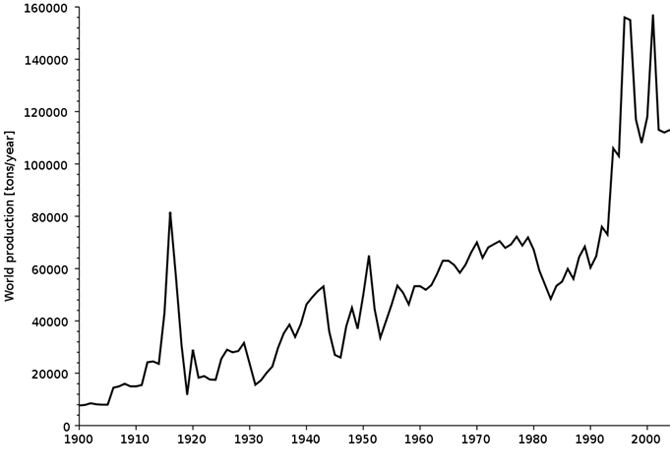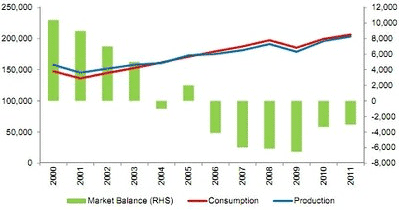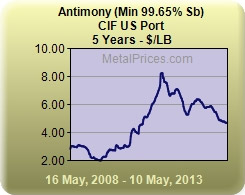Antimony |
|
|
Antimony Dynamics Antimony is a chemical element with symbol Sb and atomic number 51. It is one of the oldest elements as far as in usage, with the Ancient Egyptians having used it for make-up (kohl for the dramatic eye effects). The ancient Romans called it Stibium, hence its chemical symbol Sb. It was established to be an element around the 17th century. The abundance of antimony in the Earth's crust is estimated at 0.2 to 0.5 parts per million, comparable to thallium at 0.5 parts per million and silver at 0.07 ppm. Even though Sb is not abundant, it is found in over 100 mineral species. Antimony is sometimes found natively, but more frequently it is found in the sulfide stibnite (Sb2S3) which is the predominant ore mineral. Usages The main traditional application for metallic antimony was as an alloying material for lead and tin and for lead antimony plates in lead-acid batteries. Alloying lead and tin with antimony improves the properties of the alloys which are used in solders, bullets and plain bearings. Antimony compounds are prominent additives for chlorine- and bromine-containing fire retardants found in many commercial and domestic products. In the past, Sb prices often fluctuated with the outbreak of war because if it military applications. However, more recently the emerging growth of Sb has been for applications in microelectronics and as fire retardants (antimony trioxide-ATO). The later represents 72% of its primary antimony consumption in Europe; for China 50%; and, the US about 60%. Antimony trioxide acts as a synergist to improve the performance of other flame retardants such as aluminum hydroxide, magnesium hydroxide and halogenated compounds. This enhanced performance minimizes the amount of flame retardant required. Antimony trioxide is used in this way in many products including plastics, textiles, rubber, adhesives and plastic covers for aircrafts and automobiles. Interestingly the latest application of Sb (the flame retardant aspect) allows for virtually no recycling. Strong growth in new uses of ATO have more than offset the second most common use of Antimony alloy is (delete) as a hardener for lead electrodes in lead acid batteries. This use continues to decline as the antimony content of typical automotive battery alloys has declined by weight to 1.6% from 7% in the past. In addition, the battery use maybe further reduced because as calcium, aluminum and tin alloys are expected to replace most of the battery applications over time. Production Sources The Chinese have dominated global Antimony production since the mid-1800s with the possession of some of the most prolific mines in the world and a vast network of refineries (both major and "backyard"). In particular China's place as the largest producer of Antimony and its compounds was due to the Xikuangshan Mine in Hunan. However all "good" things must come to an end and the Chinese have staged crackdowns on the more polluting small-scale operators and this has changed not only the Chinese industry, but also has impacted the global outlook for Antimony demand. The leading firm of specialty metals consultants, Roskill, have estimated that in primary production, in 2010, China held a 76.75% share of world's supply with 120,462 tonnes (90,000 tonnes of reported and 30,464 tonnes of un-reported production), followed by Russia (4.14% share, 6,500 tonnes of production), Myanmar (3.76% share, 5,897 tonnes), Canada (3.61% share, 5,660 tonnes), Tajikistan (3.42% share, 5,370 tonnes) and Bolivia (3.17% share, 4,980 tonnes). Roskill also estimated that secondary production globally in 2010 was 39,540 tonnes. However we would note that since that time the Chinese have purchased Canada's Beaver Creek mine and shut it down while also acquiring Anchor Resources in Australia, which currently remains in limbo.
The preceding chart shows that recent years have seen a rather strong drop-off in production despite flame retardant demand rising at over 6% per annum. Reported production of Antimony in China fell in 2010 and is unlikely to increase in the coming years, according to Roskill's report. No significant antimony deposits in China have been developed for about ten years, and the remaining economic reserves are being rapidly depleted. This would appear to be a 'sunset" moment for the era of Chinese dominance of this metal.
|




 The fall in production, not unsurprisingly, produced a surge in prices of Sb to over $17,000 per ton in 2010. The price then dropped back to $12,000 per tonne in 2011 before rebounding to around $14,000 per tonne and then easing back to around $10,000 per tonne currently. Roskill estimate in their 2012 survey of the metals that prices should range between US11-14,000 per tonne over coming years. Antimony is out there with Tungsten in having a similarly resilient trend. Both, it might be noted, have a similar dynamic of dramatic over-exploitation by the Chinese combined with long term predatory pricing.
The fall in production, not unsurprisingly, produced a surge in prices of Sb to over $17,000 per ton in 2010. The price then dropped back to $12,000 per tonne in 2011 before rebounding to around $14,000 per tonne and then easing back to around $10,000 per tonne currently. Roskill estimate in their 2012 survey of the metals that prices should range between US11-14,000 per tonne over coming years. Antimony is out there with Tungsten in having a similarly resilient trend. Both, it might be noted, have a similar dynamic of dramatic over-exploitation by the Chinese combined with long term predatory pricing.